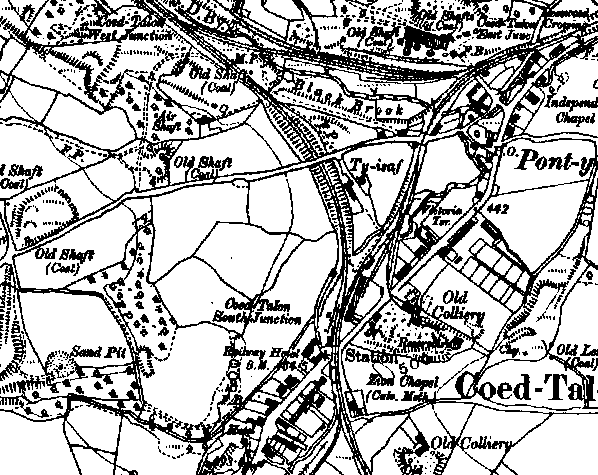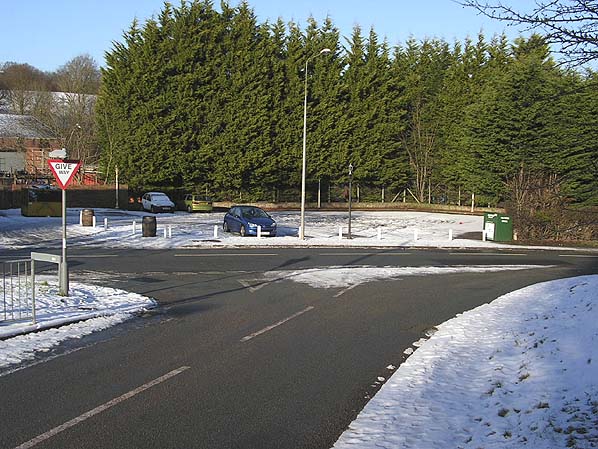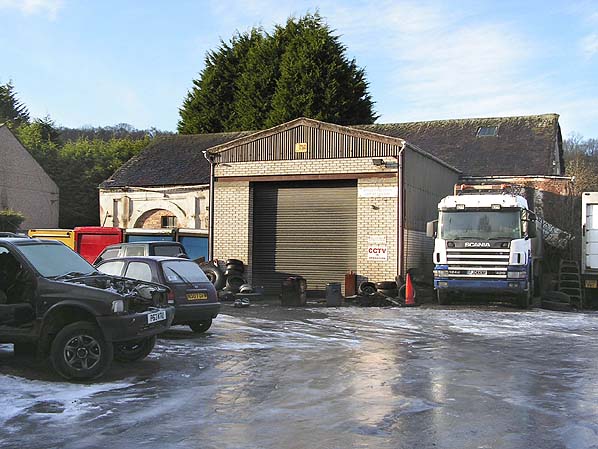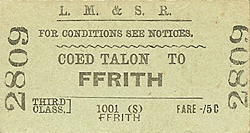
Station Name: COED TALON
talon_old2.jpg) Looking towards the north west at Coed Talon Station in LNWR days. The photograph taken from high ground gives a good overall view of the station. In the foreground can be seen the level crossing which carried the main road through the village over the line. The platform is busy with passengers who would have most likely been travelling to Mold. As all of the passengers seem to be very well dressed they are probably visiting the shops and the market at Mold on a Saturday afternoon. In the goods yard wagons belonging to the Midland Railway (MR) and the LNWR can be seen as can the station's 5 ton crane.
Copyright photo from John Alsop collection   1914 OS map talon_old3.jpg)
Coed Talon station looking north in May 1950. Passenger services had ceased a few weeks earlier on the 27th March. In the 1960s it was usual for signage and posterboards to be removed as soon as a station closed. Nobody appears to have been in any great hurry to remove the stations fixtures and fittings at Coed Talon in 1950. The picture shows a couple of points of interest. Firstly the notice board to the right of the level crossing was still headed by LMS. Obviously in the years since nationalisation in 1948 this was never changed to British Railways. Also of note is the line branching away to the right of the picture from halfway along the platform. This line follows the route of the original Ffrith branch opened in the late 1840s. The line closed in 1934 and was lifted in 1935. The section seen in this picture would have only continued for a few hundred metres at most and at this time was used for access to the goods shed which can just be seen on the right of the picture.
Copyright photo from John Alsop collection talon_old4.jpg)
Looking south at Coed Talon Station on the 15th July 1963 during the last few months of regular goods services. At this time there was a daily trip working from Mold. Passenger services had ceased thirteen years earlier.
Copyright photo by R M Casserley  Looking north at the site of Coed Talon Station in January 2010. The line paralleled the lane in the foreground on the left side of the picture before crossing the road by means of a level crossing (left). The blue car marks the site of the stations entrance gate which was on the west side of the crossing. The main station building would have been to the rear of the blue car.. This picture is taken from a similar viewpoint to the 5th picture below.
Photo by Paul Wright 
The surviving goods shed at Coed Talon in December 2009. The building was being used as a transport depot.
Photo by Paul Wright Click on thumbnail to enlarge
|




talon_old_thumb1.jpg)
smith_old_thumb8.jpg)
talon_old_thumb5.jpg)
talon_old_thumb6.jpg)
talon_old_thumb7.jpg)





 Home Page
Home Page